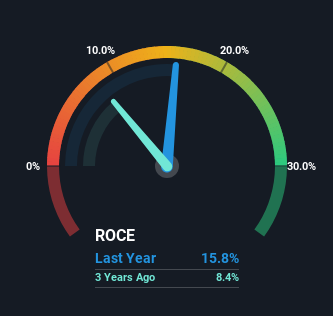
To find a multi-bagger stock, what are the underlying trends we should look for in a business? Ideally, a business will show two trends; firstly a growing return on capital employed (ROCE) and secondly, an increasing amount of capital employed. This shows us that it's a compounding machine, able to continually reinvest its earnings back into the business and generate higher returns. However, after investigating Vital Farms (NASDAQ:VITL), we don't think it's current trends fit the mold of a multi-bagger.
Return On Capital Employed (ROCE): What Is It?
Just to clarify if you're unsure, ROCE is a metric for evaluating how much pre-tax income (in percentage terms) a company earns on the capital invested in its business. The formula for this calculation on Vital Farms is:
Return on Capital Employed = Earnings Before Interest and Tax (EBIT) ÷ (Total Assets - Current Liabilities)
0.16 = US$33m ÷ (US$275m - US$65m) (Based on the trailing twelve months to December 2023).
Therefore, Vital Farms has an ROCE of 16%. On its own, that's a standard return, however it's much better than the 11% generated by the Food industry.
View our latest analysis for Vital Farms

In the above chart we have measured Vital Farms' prior ROCE against its prior performance, but the future is arguably more important. If you're interested, you can view the analysts predictions in our free analyst report for Vital Farms .
What The Trend Of ROCE Can Tell Us
In terms of Vital Farms' historical ROCE movements, the trend isn't fantastic. Over the last five years, returns on capital have decreased to 16% from 21% five years ago. Although, given both revenue and the amount of assets employed in the business have increased, it could suggest the company is investing in growth, and the extra capital has led to a short-term reduction in ROCE. And if the increased capital generates additional returns, the business, and thus shareholders, will benefit in the long run.
On a side note, Vital Farms has done well to pay down its current liabilities to 24% of total assets. That could partly explain why the ROCE has dropped. What's more, this can reduce some aspects of risk to the business because now the company's suppliers or short-term creditors are funding less of its operations. Since the business is basically funding more of its operations with it's own money, you could argue this has made the business less efficient at generating ROCE.
The Bottom Line On Vital Farms' ROCE
Even though returns on capital have fallen in the short term, we find it promising that revenue and capital employed have both increased for Vital Farms. These trends are starting to be recognized by investors since the stock has delivered a 9.2% gain to shareholders who've held over the last three years. So this stock may still be an appealing investment opportunity, if other fundamentals prove to be sound.
One more thing, we've spotted 2 warning signs facing Vital Farms that you might find interesting.
For those who like to invest in solid companies, check out this free list of companies with solid balance sheets and high returns on equity.
New: Manage All Your Stock Portfolios in One Place
We've created the ultimate portfolio companion for stock investors, and it's free.
• Connect an unlimited number of Portfolios and see your total in one currency
• Be alerted to new Warning Signs or Risks via email or mobile
• Track the Fair Value of your stocks
Have feedback on this article? Concerned about the content? Get in touch with us directly. Alternatively, email editorial-team (at) simplywallst.com.
This article by Simply Wall St is general in nature. We provide commentary based on historical data and analyst forecasts only using an unbiased methodology and our articles are not intended to be financial advice. It does not constitute a recommendation to buy or sell any stock, and does not take account of your objectives, or your financial situation. We aim to bring you long-term focused analysis driven by fundamental data. Note that our analysis may not factor in the latest price-sensitive company announcements or qualitative material. Simply Wall St has no position in any stocks mentioned.
About NasdaqGM:VITL
Vital Farms
A food company, packages, markets, and distributes shell eggs, butter, and other products in the United States.
Flawless balance sheet with moderate growth potential.
Similar Companies
Market Insights
Community Narratives



